Celebrating an Olde Fashioned
Christmas
by Bob Brooke
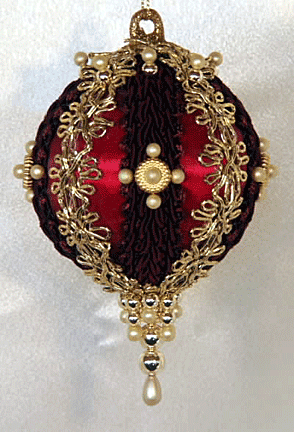 Christmas!
It comes but once a year, but what a warm and joyous holiday it is. No
other holiday in America boasts such a wealth of traditions and customs.
Christmas is familiar songs, delicious food, gifts and greeting cards,
as well as brightly lit trees and wreaths festooned with red ribbons.
And don’t forget Santa Claus and filled stockings. But all these
traditions didn't come from the same place, as did the people who
brought them to America. Christmas!
It comes but once a year, but what a warm and joyous holiday it is. No
other holiday in America boasts such a wealth of traditions and customs.
Christmas is familiar songs, delicious food, gifts and greeting cards,
as well as brightly lit trees and wreaths festooned with red ribbons.
And don’t forget Santa Claus and filled stockings. But all these
traditions didn't come from the same place, as did the people who
brought them to America.
Not only do we enjoy our uniquely American traditions---Christmas dinner
with roast turkey, stuffing, and cranberry sauce, tiny lights strung on
houses; plump Santa Claus---but we also celebrate in ways that reflect
the diverse backgrounds of our immigrant ancestors. Their holiday
traditions, transplanted here from many countries, have taken root and
thrived.
A Colonial Christmas
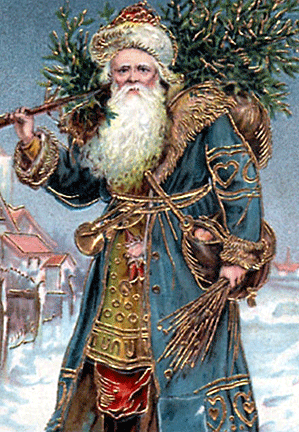 To
the first English colonists who arrived in Virginia in 1607, Christmas
was both a holy day and a festival which they celebrated here with the
same merriment and feasting that they did in England. They also began
the practice of exuberant noise-making, with horns, drums, and
firecrackers, that's still part of Christmas in the South. To
the first English colonists who arrived in Virginia in 1607, Christmas
was both a holy day and a festival which they celebrated here with the
same merriment and feasting that they did in England. They also began
the practice of exuberant noise-making, with horns, drums, and
firecrackers, that's still part of Christmas in the South.
Early American Christmas celebrations were simple by necessity. Life
offered few luxuries, and most families struggled just to survive. But
the Pilgrims took a dim view of the singing and dancing, feasting and
drinking that characterized the Yuletide celebration back in England.
For them, Christmas was strictly a religious event, and merrymaking on
this holy day was an unwelcome reminder of pagan winter rites. So the
Pilgrims who landed in Massachusetts in the winter of 1620 spent
December 25th erecting their first building, refusing to make the day
special in any way. By the Revolutionary War, they began to lift their
bans, but it was not until 1856 that Massachusetts recognized Christmas
as a legal holiday.
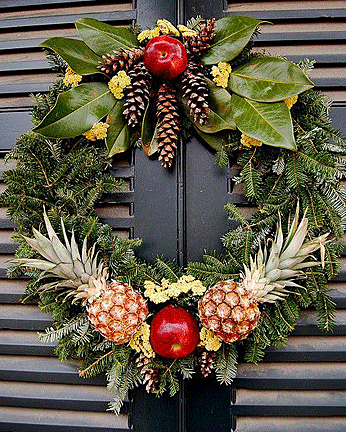 Fortunately,
Christmas was cheerier elsewhere in the colonies. On Christmas day,
1624, an expedition of the Dutch East India Company went ashore to the
now island of Manhattan to give thanks with a merry feast. As more
colonists arrived from Holland, they brought their Christmas customs of
a gift-bearing St. Nicholas, the stocking filled with treats, and the
spirit of family closeness that's so much a part of Christmas today. Fortunately,
Christmas was cheerier elsewhere in the colonies. On Christmas day,
1624, an expedition of the Dutch East India Company went ashore to the
now island of Manhattan to give thanks with a merry feast. As more
colonists arrived from Holland, they brought their Christmas customs of
a gift-bearing St. Nicholas, the stocking filled with treats, and the
spirit of family closeness that's so much a part of Christmas today.
Other immigrants along the Atlantic seaboard joined the Dutch in keeping
a merry Christmas. With the Scandinavians who settled in Delaware in
1638 came the legend of gift-giving elves, as well as the custom of
hanging a wreath of fir or pine boughs on the front door as a sign of
welcome and a symbol of good luck. A century or so later, German
colonists introduced the practice of decorating evergreen trees with
candles, cookies, and ornaments.
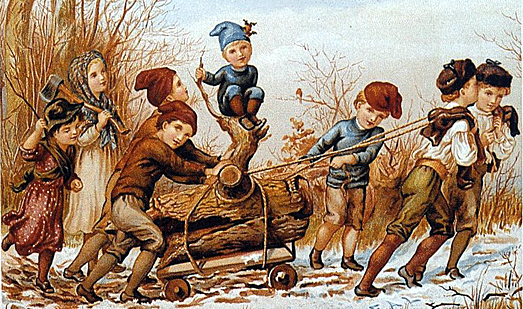
Christmas in the southern states was a convivial affair, the American
counterpart of the English Yuletide revelry. It wasn't so much an
occasion for gift giving as for friendship and hospitality. In
Williamsburg, Virginia, people lit the Yule log as the foundation of the
traditional Christmas Eve fire, and gathered to sing carols. The Yule
log played a special role in holiday observances. As long as it burned,
usually throughout Christmas week, no one was expected to work. Not
surprisingly, people went to great lengths to keep the giant log ablaze.
The next morning they attended church services, and then the festivities
began--banquets, dances, games, hunts, and fireworks--sometimes
continuing until the New Year.
Other Early Christmas Traditions
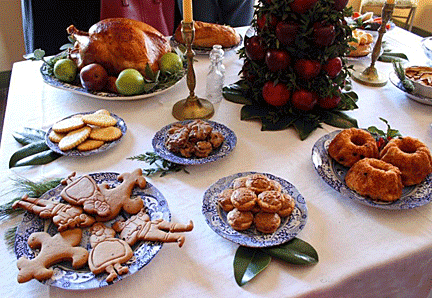 In
the huge expanse of country beyond the 13 original colonies, other
traditions took hold. From the Great Lakes to Louisiana, French settlers
attended a midnight mass on Christmas Eve, then sat down to a special
supper called a reveillon. Children left their shoes by the creche
before going to bed, in hopes that the infant Jesus would fill them with
gifts. For most French-American families Christmas was a time of peace
and contemplation. The secular celebration waited until New Year's Eve,
which they celebrated with a town festival complete with parades,
masquerade balls and the like. In
the huge expanse of country beyond the 13 original colonies, other
traditions took hold. From the Great Lakes to Louisiana, French settlers
attended a midnight mass on Christmas Eve, then sat down to a special
supper called a reveillon. Children left their shoes by the creche
before going to bed, in hopes that the infant Jesus would fill them with
gifts. For most French-American families Christmas was a time of peace
and contemplation. The secular celebration waited until New Year's Eve,
which they celebrated with a town festival complete with parades,
masquerade balls and the like.
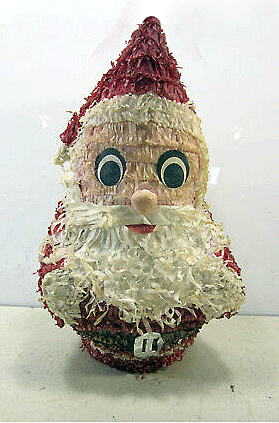 Spanish
communities in what's now Texas and in the mission settlements of the
Southwest re-enacted the journey of Mary and Joseph on the first
Christmas. Called Las Posadas, this combination procession, play, and
pageant was followed by a lively celebration. At the height of the
festivities, children swung at a pinata with a large stick, and when it
broke scrambled after the toys and sweets that spilled out. Spanish
communities in what's now Texas and in the mission settlements of the
Southwest re-enacted the journey of Mary and Joseph on the first
Christmas. Called Las Posadas, this combination procession, play, and
pageant was followed by a lively celebration. At the height of the
festivities, children swung at a pinata with a large stick, and when it
broke scrambled after the toys and sweets that spilled out.
As the tide of immigrants swelled in the 19th century, new Christmas
customs appeared. It was at this time, too, that Christmas assumed
national importance. By the 1840s, Clement C. Moore's classic poem "'Twas
the Night Before Christmas" became a family favorite. Christmas parties
and gift giving, Santa Claus and ornamented trees were common to the
whole country by 1860.
A Victorian Christmas
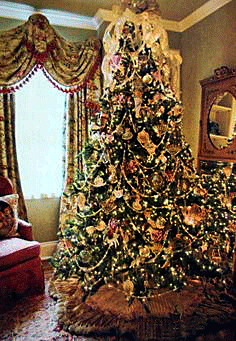 By
the 1890s, the height of the Victorian era, Christmas had acquired many
modern traditions. During the Victorian Era from 1837 to 1901, people
celebrated Christmas with special family gatherings, feasting,
embellishing the home with decorations, and gift giving in increasing
abundance. Victorians loved to decorate for the holidays. A giant fir
tree, adorned with dried hydrangeas in shades of rose and pale green,
lacy fans, white silk roses(a symbol of the Virgin Mary), German glass
balls, and delicate handmade paper ornaments, held together with lace
garland, woven with ribbon and strung fresh cranberries, stood in the
parlor. Many people believe that the Christmas tree evolved from the
Paradise tree, a fir hung with red apples and wafers(the host) which
represented the Garden of Eden in a medieval miracle play about Adam and
Eve performed on December 24. By
the 1890s, the height of the Victorian era, Christmas had acquired many
modern traditions. During the Victorian Era from 1837 to 1901, people
celebrated Christmas with special family gatherings, feasting,
embellishing the home with decorations, and gift giving in increasing
abundance. Victorians loved to decorate for the holidays. A giant fir
tree, adorned with dried hydrangeas in shades of rose and pale green,
lacy fans, white silk roses(a symbol of the Virgin Mary), German glass
balls, and delicate handmade paper ornaments, held together with lace
garland, woven with ribbon and strung fresh cranberries, stood in the
parlor. Many people believe that the Christmas tree evolved from the
Paradise tree, a fir hung with red apples and wafers(the host) which
represented the Garden of Eden in a medieval miracle play about Adam and
Eve performed on December 24.
Arrangements of fresh greens and holly, a pagan custom adapted by
Christians, decorated Victorian homes. The color green came to symbolize
the Christian belief in eternal life through Christ. Legend says that
Jesus' crown of thorns was plaited from holly. It's said that, before
the crucifixion, the berries of the holly were white, but afterward,
they turned crimson, like drops of blood.
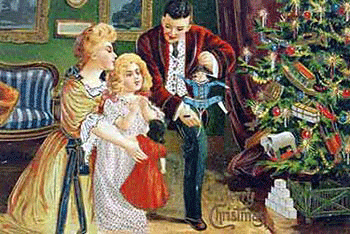 Greens
hung from chandeliers. Pine roping, wrapped with pearls and pink moire
taffeta bows, draped the grand staircase. Perhaps a small wooden tree
covered with prisms stood on a marble-top table. Another, covered in
intricate origami birds, might have stood on a hall table. The crowning
touch was a large welcoming wreath that hung on the vestibule door
flanked by alabaster urns filled with gold tinged twisted willow and red
poinsettias. But the most important part of the Victorian celebration
was the family's creche, which featured carved figures of Mary, Joseph
and the Christ Child set in a miniature village, complete with meadows,
fences, windmills and ponds. flanked by poinsettias. Many believe St.
Francis of Assisi created the first creche using live animals in 1223. Greens
hung from chandeliers. Pine roping, wrapped with pearls and pink moire
taffeta bows, draped the grand staircase. Perhaps a small wooden tree
covered with prisms stood on a marble-top table. Another, covered in
intricate origami birds, might have stood on a hall table. The crowning
touch was a large welcoming wreath that hung on the vestibule door
flanked by alabaster urns filled with gold tinged twisted willow and red
poinsettias. But the most important part of the Victorian celebration
was the family's creche, which featured carved figures of Mary, Joseph
and the Christ Child set in a miniature village, complete with meadows,
fences, windmills and ponds. flanked by poinsettias. Many believe St.
Francis of Assisi created the first creche using live animals in 1223.
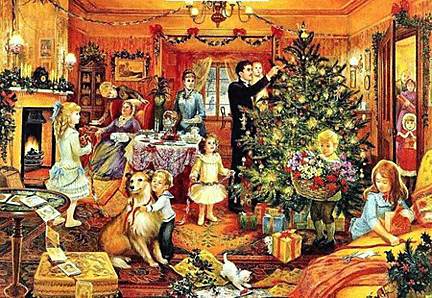
Gift giving played an important role in Victorian celebrations. The lady
of the house would smile as she peeled back the tissue covering a
heavily embossed sterling silver dresser set or opened a box in which a
pair of gold and amethyst earrings nestled. Children often received
books, considered appropriate for their educational or moral value. Or
perhaps a doll's china tea service and sewing equipment for the girls,
and miniature tools for the boys to help prepare them for adulthood. Men
weren't left out. To go walking, a man might receive a gold-tipped cane
or a fine ivory meerschaum pipe.
Then as now, Americans remembered the true meaning of Christmas through
generosity and charitable deeds. While they made merry with family and
friends, they also recalled the origin of this once-a-year event,
exemplified in star-topped trees, Nativity scenes, performances of
Handel's Messiah, and above all the sharing of joy and love with their
loved ones.
<
More Special Features
Next Article > |
